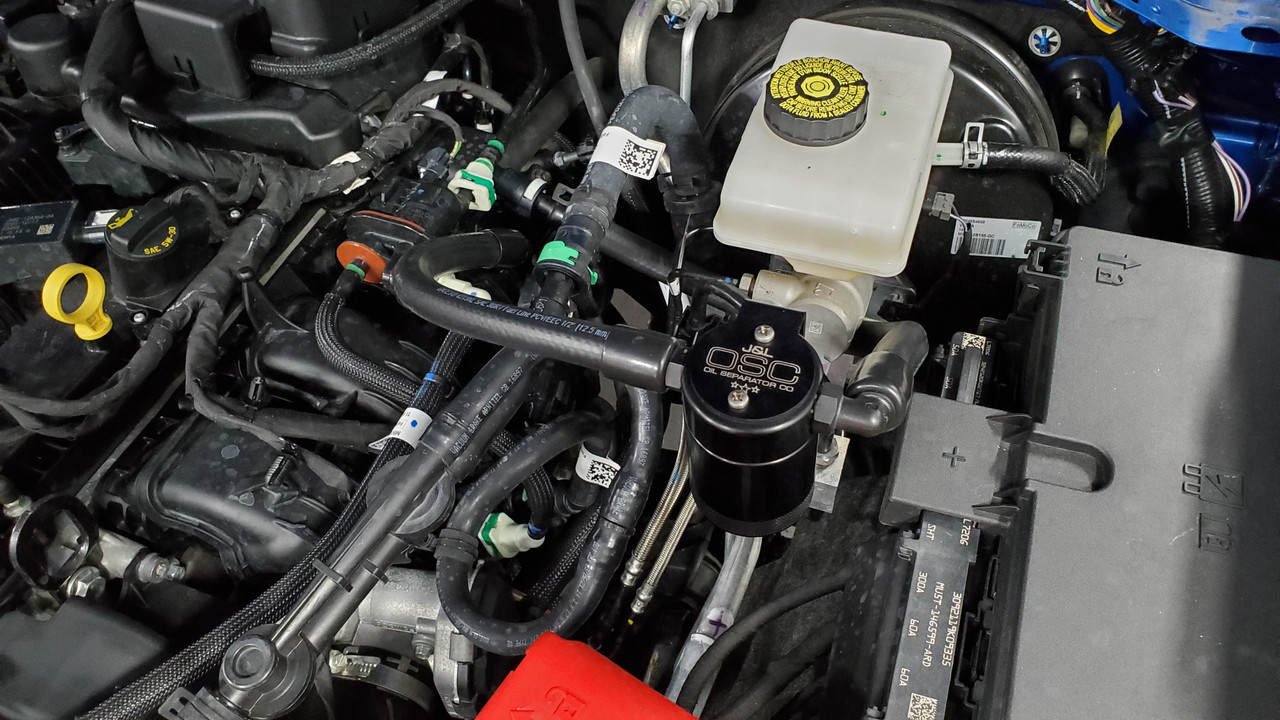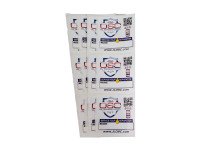J&L Oil Separator Co.
J&L Oil Separator 3.0 Driver Side (2021.5-2024 Ford Bronco 2.3L EcoBoost)
- SKU:
- 3075P
- CARB Status:
- NOT CARB EXEMPT
- Instructions:
- Click to Download PDF
- Extension Compatible?:
- YES
FITMENT:
2021.5-2024 Ford Bronco 2.3L Ecoboost
**Please note, Ford changed the PCV line location in the middle of the 2021 model year. This oil separator only fits the later year change. We believe the change happened in 10/21 build dates. Please check over the install directions and compare to your own Bronco if you have a 2021! There is a picture above that circles this lines location!
J&L 3.0 Oil Separator
3oz Capacity
Solid billet construction.
Plug-N-Play Design
Limited Lifetime Warranty
Looking for more capacity?
This application is compatible with our reservoir extension, increasing the capacity from 3oz to 6oz total. Click this LINK for more info!
How does it work?
During the process of venting crankcase pressure back through your intake track, large amounts of oil, in the form of vapors can gather/accumulate in your intake tube, intake manifold runners and even dilute your gas, lowering its octane level. This happens on all engines and is even worse with forced inducted vehicles (supercharged and turbocharged) as crankcase pressures are increased. To combat this, we have developed an oil separator of our own design. Milled from solid billet aluminum this is a rock-solid piece. It has a knurled tank base for easy removal to drain the spent oil and an O-ring seal to prevent any leaks.
Filtering consists of a fine mesh stainless steel filter that traps fine oil vapors and releases them once heavy enough to fall. By the time the oil gets through the filter, it's too heavy to be passed on into the intake. The tank holds 3 oz of fluid, while that may not sound like a lot, you shouldn’t see that much oil in your PCV system. Check the oil separator after 1000 miles of driving. Most applications can make it 2500-3500 before filling the unit but every vehicle is different!
WHY J&L?
Our Oil Separators are easy install, service and flat out work! Many use OEM hoses or come complete with all hoses, custom brackets and hardware for an OEM look. Retain stock hose if you ever return to stock.
FREE SHIPPING WITHIN US
*This product is NOT CARB (California Air Resource Board) Exempt. It is not for legal sale or use in the state of CA or any other states adopting CA emission standards and require a CA Executive Order (EO) number. Any orders placed for this item with a CA ship to address will be cancelled.
15 Reviews Hide Reviews Show Reviews
-
Oil can - Bronco 2.3L
Love this product, way easier to install than any other product and cheaper, too. The Pcv valve is located under this engine, meaning that if you want to replace that hose and attachment, you need to take off the front driver wheel, wheel liner, and get your girlfriend to use her skinny arms and fingers to remove this off the engine. This product does not require you to do that unlike the much more expensive products. Finally, this is located in a much better spot to quickly empty the can, rather than being in the rear of the engine bay. It’s cheaper, but not cheap parts, easier to install, and easier to maintain…
-
Bronco 2.3 oil separator
Works!
Easy install, quality part,
Like it enough to have purchased another for
My wife’s Bronco sport 1.5l -
Bronco 2.3 oil seperator
Install was easy and only took about 5 minutes. Fit and finish are perfect. Now I just need the bigger can.
-
Oil separator 2.3 eco
After Lots of research , the overriding recommendation on a solely direct injection engine is to catch crank case emissions BEFORE they reach the intake manifold. I did the usual Google-fu and found several products, However the J&L was about as plug and play as I could find. Matched connectors, prefabbed can mount in a convenient location and a great demo video. I didn’t have to pull fender wells, dig behind the block, or cut anything. Install was just as easy as the video with NO surprises. I’m going to start checking every 1k miles and adjust from there, but if I can extend the time before I need walnut blasting of the valves , this was money well spent. Looks factory and high quality components, highly recommended
Inside the oil separator there is a filter. The filtered side of the can should always go to the PCV valve or “dirty” connection. The filter is what turns the oil vapor into liquid form to be collected in the basin of the unit. You want this to happen as it is entering the can. The open port will run to your intake.
In most cases you only need an oil separator on the PCV side (dirty side) of the engine. This is the side that is under vacuum/suction most of the time while the vehicle is running and driving. The clean side typically is only used for venting when the PCV valve is closed which is under moderate to high acceleration.
Some turbo vehicles can see oil in the clean side, such as Ecoboost F-150’s when they are exposed to frequent towing conditions.
On non-turbo applications anything short of road course racing you typically will not see a drop of collection out of the clean side.
For most Ford applications there is a grey or green tab, you press in this larger tab. It is a button; it will release the fitting and you pull up on the fitting with the button pressed. ***DO NOT REMOVE THE CLIPS FROM THE FITTING! YOU WILL BREAK THEM!!***
For GMC/Chevy applications there is a single button release. This release and the location of some of these fittings can be tricky. You must press the bottom squarely and pull the fitting straight off. Many people make the mistake of pressing the button too hard and it flexes the release. Take your time and it will release. The 5.3L intake fittings are the toughest due to their location.
Most applications average about an ounce of oil every thousand miles. However, there are many factors in collection rate as every single engine is different. Factors such as driving style, climate, engine condition, oil level all vary and effect collection rate.
People in cold climates will have to check their oil separator more often in the winter months due to condensation build up occurring in the oil separator itself. In these months, the air entering the can is significantly hotter than the ambient air temp. This results in condensation build up (think hot shower in a cold bathroom).
We recommend everyone to check their oil separator at 500-1000 miles of driving to get an idea of how often it needs to be serviced. The can holds 3 ounces without the optional extension.
Your J&L Oil Separator is Guaranteed for Life! Click here for more details on your J&L Oil Separator Co. Warranty
Every 15K+ Miles you will want to thoroughly clean the oil separator, Click here to view the How-To video
The specs on the screws are M4 x .7 x 10mm, they can be found at just about any hardware store.
Sometimes when the oil separator is over tightened it can be tough to remove; also some oil separators are much more accessible once installed than others.
If you are having trouble removing the oil separator reservoir, try removing it from the bracket or even vehicle to get a better grip on it. For units that are really tough, we recommend a rubber oil filter strap wrench. You can use this in combination with a rag and typically remove them without damage.
When reinstalling the can bottom, treat it like an oil filter. Screw the can to the bottom of the O-ring. Give it another ¾ to 1 full turn. No more, no less.
No! Dispose of this nasty oil that is mixed with fuel, water and everything else where you would dispose of your oil change oil. Many auto parts stores will take your old oil for free of charge.
If you read the fine print on any warranty contract you will find a lot of reasons your warranty can become void; installing aftermarket parts can be one of them.
However, per the Magnuson–Moss Warranty Act proof would have to be provided that the after-market part caused the failure.
If you need further clarification, contact your vehicles service department. Some are easier to deal with than others.
You will receive automated emails through our website when an order is placed and when the status is changed.
Gmail users will often find these emails under the “promotional tab”.
Yahoo users will often find all our order updates in their spam/junk folder.
When your order ships you will often get emails from the shipping service with tracking, your order in your customer portal will also have the tracking information.
Please be sure to check these folders prior to contacting us for further updates.
You can view our Return Policy by Clicking Here
We primarily use USPS and UPS for our shipping services, if you require expedited shipping or specific service please call 757-842-6497 to place your order or to get shipping quotes.
Small items such as replacement parts typically ship USPS First class mail.
Canadian orders placed through the website all ship USPS Priority International.































